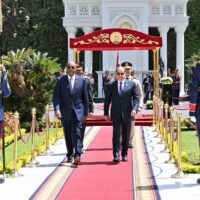Gold prices in Egypt’s local market remained stable during Saturday’s trading session, coinciding with the weekly closure of global exchanges. This steadiness followed a volatile week that saw global gold prices swing sharply as investors liquidated holdings to offset stock market losses, according to a report by iSagha, an online platform for gold and jewellery trading.
Said Emababy, CEO of iSagha, confirmed that the price of 21-karat gold stabilized at EGP 4,375 per gram, unchanged from Friday’s close. Meanwhile, the global ounce price fell by 1.5% over the week, shedding $47 to close at $3,038, after briefly reaching a record high of $3,168 on 3 April. This drop ended a five-week winning streak, with prices retreating by 4.2% from their peak.
In Egypt, the price of 24k gold reached EGP 5,000 per gram, while 18k gold was priced at EGP 3,750, and 14k gold at EGP 2,917. A gold pound (8 grams of 21k gold) was priced at approximately EGP 35,000.
Despite Saturday’s stability, gold prices fell by EGP 50 during Friday’s session alone. The price of 21k gold had opened at EGP 4,425 before settling at EGP 4,375. Globally, the ounce price also dipped from $3,135 to $3,037, losing $98 in a single day.
Emababy noted that ongoing disruptions in global markets have led local traders to rely on a parallel dollar rate when pricing gold, causing the local market price to exceed the global equivalent by around EGP 61 per gram. He explained that while the Central Bank’s official dollar rate was EGP 50.58, the rate used within the gold market had climbed to EGP 51.20, reflecting traders’ efforts to shield themselves from volatility.
He added that in recent months, gold pricing had been based on a dollar rate below the official figure due to subdued demand and a strategic focus on exporting gold to generate liquidity. This shift has now reversed as demand surges and uncertainty persists.
Emababy advised against buying gold during this period of heightened fluctuation, recommending that investors wait for price stabilization. However, he described the current environment as favorable for resale, particularly given the growing gap between local and global prices.
In the first quarter of 2025, local gold prices surged by 18%, or EGP 680, while global prices rose by 19%, gaining $502. This marked gold’s strongest quarterly performance in nearly four decades.
The iSagha CEO attributed the global rally in gold prices to escalating trade tensions following US President Donald Trump’s announcement of sweeping tariffs. These measures have rattled markets and raised fears of a global recession. Emababy emphasized that despite recent pullbacks, gold continues to serve as a robust hedge against inflation, market downturns, and geopolitical risk.
He added that Trump’s tariffs—though excluding precious metals—have upended global supply chains, causing the largest trade disruption since the COVID-19 pandemic. As stock markets falter under inflationary pressure and economic slowdown, investors have increasingly turned to gold for safety.
Gold stocks on the COMEX exchange have surged by 720 tonnes since the beginning of the year, although Emababy expects that this momentum may soon ease as demand stabilizes.
Meanwhile, a US non-farm payroll report showed the addition of 228,000 jobs in March, while the unemployment rate edged up to 4.2%. The new U.S. tariffs have further clouded the outlook for industrial activity and supply chains, adding more volatility to global commodity markets.
Markets now await several key US economic indicators next week, including the Federal Reserve’s March policy meeting minutes on Wednesday, followed by the Consumer Price Index on Thursday and the Producer Price Index on Friday.




